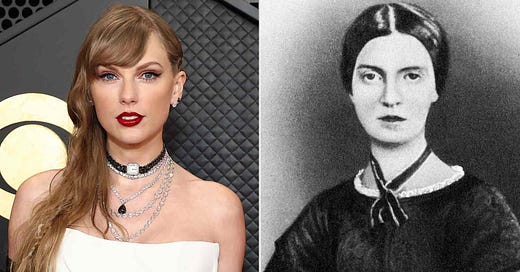I was catching my breath: Taylor Swift and Emily Dickinson
Episode 84, our Show & Tell on Taylor Swift and Emily Dickinson is available now!
“And I was catching my breath, barefoot in the wildest winter…” What happens when a 21st-century American poet meets a 19th-century one? In this Show & Tell episode, we explore the literary lineage between Taylor Swift and Emily Dickinson—two iconic writers whose work spans centuries but shares unmistakable DNA (literally—did you know they might be distant cousins?!). From slant rhymes and stylized punctuation to themes of isolation, longing, and hope, we unpack the poetic parallels between Dickinson’s timeless verses and Taylor’s lyrics. In true Show & Tell fashion, each of us brings a favorite Dickinson poem paired with a Swift song that touch on shared motifs such as separation, isolation, and hope. Tune in to find out which modern-day Taylor tracks sound like 19th-century poetry—and why we think Emily might vibe with Evermore.
🎧 Listen above and ⬇️ scroll below to read Maansi’s extra credit about some bonus Emily Dickinson references in Taylor Swift’s music.
✨ We want to hear from you! ✨
Whether you listen weekly, read occasionally, or just joined us—this quick survey helps us understand who’s here and how to make the podcast + newsletter even better. It takes 5 minutes, and we’d be so grateful for your input.
🎥 Sneak Peek
Catch excerpts from the podcast and behind-the-scenes content on YouTube, TikTok, and Instagram.
📜 This Week’s Extra Credit by Maansi
On this week’s episode, we each brought an Emily Dickinson poem and a corresponding Taylor Swift song to our show & tell. But while we use some creative liberties in drawing these connections, Taylor Swift does actually have more explicit references to Emily Dickinson in her discography. As promised, I wanted to take this space to explore those “honorable mentions.”
Evermore, the album
In this week’s episode, Jodi brought the song “Evermore”, from the album of the same name. But the album itself is pretty interesting as well. Taylor Swift actually introduced this album on December 10, 2020, which also happened to be Emily Dickinson’s 190th birthday.
There’s been some speculation online that perhaps the title of this album was inspired by Dickinson’s poem “One Sister I Have In Our House,” which ends with the word “forevermore”. This poem speaks of two sisters — “there’s only one recorded, but both belong to me” which can have some significance when it comes to Taylor recording her music. Also Evermore was considered to be a sister album to Folklore, which dropped earlier that year.
Here is the text of the full poem.
One Sister have I in our house -
And one a hedge away.
There's only one recorded,
But both belong to me.
One came the way that I came -
And wore my past year's gown -
The other as a bird her nest,
Builded our hearts among.
She did not sing as we did -
It was a different tune -
Herself to her a Music
As Bumble-bee of June.
Today is far from Childhood -
But up and down the hills
I held her hand the tighter -
Which shortened all the miles -
And still her hum
The years among,
Deceives the Butterfly;
Still in her Eye
The Violets lie
Mouldered this many May.
I spilt the dew -
But took the morn, -
I chose this single star
From out the wide night's numbers -
Sue - forevermore!“Ivy,” Evermore
It is common knowledge that Emily Dickinson was very close with her sister-in-law Sue and felt a forbidden love for her. We also happen to know that Emily Dickinson would frequently use ivy imagery in her own writing. The kind of yearning in the song Ivy is reminiscent of the kind of longing Dickinson conveys in poems like “One Sister I Have in Our House,” and others whenever she mentions Sue, and so many believe this song to be an ode to Emily Dickinson and her love.
“I hate it here,” The Tortured Poets Department
The line “Nostalgia is a mind trick, if I'd been there, I'd hate it.” This sentiment is reminiscent of a poem by Emily Dickinson, called “I had no time to Hate.”
I had no time to Hate -
Because
The Grave would hinder me -
And Life was not so
Ample I
Could finish--Enmity -
Nor had I time to Love -
But since
Some Industry must be -
The little Toil of Love -
I thought
Was large enough for Me .
Reputation, the album
Reputation as an album is actually a subtle and underrated ode to Emily Dickinson. Aesthetically, the reputation era is dark and ominous. And yet the content of the album contains some beautifully written love songs. The album itself was written in complete isolation, and Taylor has famously said that “there will be no explanation.” Emily Dickinson’s poems are also known to convey a deep sense of isolation, though many of the poems are very romantic and convey a deep sense of longing. The vast majority of her poems were not discovered until after her death, which means that even for her poetry, there was no explanation.
There’s enough there in her music to appreciate that Taylor has an appreciation for Emily Dickinson’s works. Sprinkle in the fact that the two are distantly related makes it even more fun to draw these connections! What are some Dickinson references you’ve found in Taylor’s music? Tell us in the comments!







